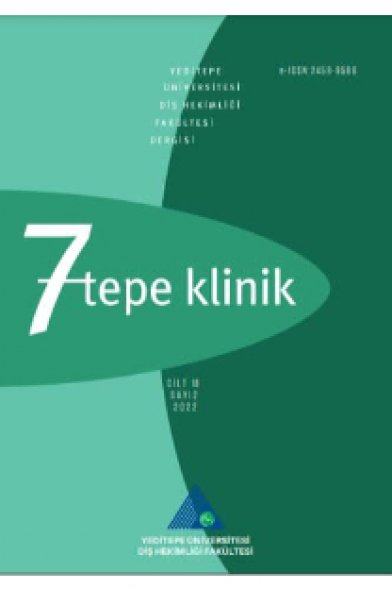Hareketli bölümlü protezlerde planlama farklılıkları ve hataları
Planning differences and design errors for removable partial dentures
___
- Polychronakis N, Sotiriou M, Zissis A. A survey of removable partial denture casts and major connector designs found in commercial laboratories, Athens, Greece. J Prosthodont 2013; 22: 245-249.
- Moreno A. Epidemiological data and survival rate of removable partial dentures. J Clin Diagn Res 2016; 10: ZC84-87.
- Güzel KG, Meşe A. Hareketli bölünlü protez planlamasında laboratuarların önemi. J Dental Sci 2002; 8: 31-35.
- Benso B, Kovalik AC, Jorge JH, Campanha NH. Failures in the rehabilitation treatment with removable partial dentures Acta Odontol Scand. 2013; 71: 1351-1355.
- Campbell SD . Removable partial dentures: The clinical need for innovation. J Prosthet Dent 2017; 118: 273-280.
- Davenport JC, Basker RM, Heath JR, Ralph JP, Glantz PO. The removable partial denture equation. Br Dent J 2000; 189: 414-424.
- Stratton RJ, Wielbelt FJ. An atlas of removable partial denture design. Quintessence Publishing Co., Inc. 1988.
- McGarry TJ . Classification system for partial edentulism. J Prosthodont 2002; 11: 181-193.
- Charyeva OO, Altynbekov KD, Nysanova BZ. Kennedy classification and treatment options: a study of partially edentulous patients being treated in a specialized prosthetic clinic. J Prosthodont 2012; 21: 177-180.
- AL-Dwairi ZN. Partial edentulism and removable denture construction: a frequency study in Jordanians. Eur J Prosthodont Restor Dent 2006; 14: 13-17.
- Öwall BE, Bieniek KW, Spiekermann H. Removable partial denture production in western Germany. Quintessence Int 1995; 26: 621-627.
- Curtis DA, Curtis TA, Wagnild GW, Finzen FC. Incidence of various classes of removable partial dentures. J Prosthet Dent 1992; 67: 664-667.
- Schwarz WD, Barsby MJ. A survey of the practice of partial denture prosthetics in the United Kingdom. J Dent 1980; 8: 95-101.
- Lynch CD, Allen PF. Why do dentists struggle with remov¬able partial denture design? An assessment of financial and educational issues. Br Dent J 2006; 200: 277–281.
- Neto AF . Evaluation of senior Brazilian dental students about mouth preparation and removable partial denture design. J Dent Educ. 2010; 74:1255-1260.
- Pun DK, Waliszewski MP, Waliszewski KJ, Berzins D. Survey of partial removable dental prosthesis (partial RPD) types in a distinct patient population. J Prosthet Dent 2011; 106: 48-56.
- ISSN: 2458-9586
- Yayın Aralığı: Yılda 3 Sayı
- Başlangıç: 2005
- Yayıncı: Yeditepe Üniversitesi Rektörlüğü
HÜSEYİN AKÇAY, Harun GÖRGÜLÜ, UTKU KÜRŞAT ERCAN, MURAT ULU, Fatma İBİŞ, Emina Afra DEMİRCİ, OZAN KARAMAN
MURAT ALKURT, ZEYNEP YEŞİL DUYMUŞ, MUSTAFA GÜNDOĞDU, Fikret Özgür COŞKUN, Tugay ŞİŞCİ, Mustafa YILDIRIM
Tolga ŞİTİLCİ, Kardelen CAN, Mehmet YALTIRIK
Ekstraoral fistül: Bir olgu sunumu
Maksiller sinüs patolojilerinin konik ışınlı bilgisayarlı tomografi ile değerlendirilmesi
Değişen sinterleme sürelerinin dental zirkonyanın optik özellikleri üzerine etkisi
Mandibulada kompound odontoma ile ilişkili dev bir dentigeröz kist: Bir olgu sunumu
Hüseyin Can TÜKEL, Sercan KÜÇÜKKURT, Emre BARIŞ
Hareketli bölümlü protezlerde planlama farklılıkları ve hataları
Ceyhun CANPOLAT, Burcu BAL, Zeynep ÖZKURT KAYAHAN, Ender KAZAZOĞLU
